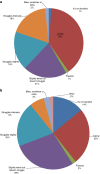The current state of welfare, housing and husbandry of the English pet rabbit population
- PMID: 25532711
- PMCID: PMC4307134
- DOI: 10.1186/1756-0500-7-942
The current state of welfare, housing and husbandry of the English pet rabbit population
Abstract
Background: The welfare of pet rabbits is an area of growing interest in Europe and the UK. This study analyses questionnaire results from a diverse population of 1254 rabbit owners from three different geographical areas in England with the aim of providing an accurate representation of how pet rabbits are currently housed and cared for and key aspects of their health and welfare.
Results: Rabbits were kept in a variety of different housing types, the most common being a traditional hutch/cage (59%). Although the majority had additional exercise areas, access was often unpredictable, or ill-timed, which may compromise welfare. Only 41.9% of owners kept their rabbit with conspecifics, limiting their ability to engage in social behaviour. Of those rabbits housed with a companion, although many were reported to be amicable and to engage in positive interactions, over a quarter were reported to fight at least occasionally (25.3%), whilst 22.7% guarded resources and 27.1% avoided one another. Whilst low levels of some of these behaviours may be a normal part of social interaction, the relatively high levels reported here suggest that not all cohabiting pairs of rabbits are compatible, which is potentially a significant welfare issue.Although the vast majority of owners fed hay for over 10% this was less than daily. Pelleted foods were very popular (71.4% at least daily) compared to commercial muesli mixes (32.6%). As in previous studies, dental problems were commonly reported (12.2% of rabbits); however, so were eye problems (12.9%), digestive problems (11.5%) and parasites (11.3%). A large proportion of rabbits (58%) were thought to be fearful of loud noises, and 61% were not reported as calm when handled by their owner, which may be a significant concern for this species.
Conclusion: This study has confirmed and expanded on previous findings: many pet rabbits were found to be in good health, had compatible companions and were provided with enriched living areas. However, it also found numerous welfare issues that affect large numbers of pet rabbits. We suggest further studies are required exploring the accuracy of owner reports (which possibly under-report many problems) and prioritising the issues raised here.
Figures






References
-
- Schepers F, Koene, Beerda B. Welfare assessment in pet rabbits. Anim Wel f. 2009;18:477–485.
-
- PDSA . PDSA Animal Wellbeing Report. 2011.
Publication types
MeSH terms
LinkOut - more resources
Full Text Sources
Other Literature Sources
Research Materials

